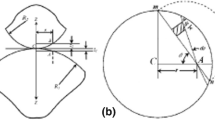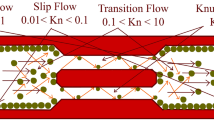Abstract
The resistance to gas flow offered by a porous medium can be utilised in the determination of permeable porosity. Transient and steady-state transport, in both the viscous and Knudsen flow regimes, is discussed theoretically. Experimental procedures are described, and illustrated with results obtained for constructional materials.
Résumé
L’écoulement permanent des gaz dans un milieu poreux n’intéresse que les pores accessibles et qui offrent réellement une voie de passage. Dans les conditions transitoires, avant qu’un régime permanent soit instauré, sont impliqués aussi les pores en cul de sac qui, bien qu’ouverts, ne constituent pas une voie de passage. Dans les deux cas, les conditions d’écoulement dépendent aussi du rapport entre le libre parcours moyen et le diamètre des pores. Pour une faible valeur de ce rapport, l’écoulement est visqueux; pour un rapport important, un écoulement de Knudsen s’instaure. On donne ici les équations qui décrivent l’écoulement et la diffusion de ces diverses conditions, et l’on montre que la porosité perméable peut être déterminée. On décrit des méthodes expérimentalement appropriées et l’on donne des résultats typiques correspondants obtenus sur des matériaux de construction.
Similar content being viewed by others
References
Hug S.—Beitrag zur Klärung der Permeationsvorgänge in Zementpasten und hochverdichteten Zementkörpern. Dissertation, Aachen (1971).
Timofeev D.P.—The mechanism of transport of matter in porous sorbents. Russ. chem. rev., 29 (1960), 180.
D’Arcy H.P.G.—Les fontaines publiques de la ville de Dijon. Dalmont, Paris (1856).
Carman P.C.—Flow of gases through porous media. Butterworth Scientific Publications, London (1956).
Žagar L.—Die Grundlagen zur Ermittung der Gasdurchlässigkeit von feuerfesten Baustoffen. Arch. Eisenhüttenwesen, 26 (1955) 777.
Bohlken, S.F.—Die Beziehung zwischen der Durchlässigkeit und der Porosität von feurfestem Material. Het gas, Den Haag, 56 (1936), 58.
Brémond P.—La perméabilité gazeuse des produits céramiques à diverses températures. Bull. de l’Inst. Céram. Fr. Nr. 5 (1933).
Wyckhoff R.D., Botset H.G., Muskat M., Reed, D.W.—The measurement of the permeability of porous media for homogeneous fluids. Rev. sci. instr., 4 (1933), 394.
Barrer R.M., Grove D.M.—Flow of gases and vapours in a porous medium and its bearing on adsorption problems. Trans. Faraday Soc., 47 (1951), 826.
Manegold E.—Kapillarsysteme Bd. 1, Straßenbau, Chemie und Technik, Heidelberg (1955), 142.
Ziemens K.E.—Kennzeichnung, Herstellung und Eigenschaften poröser Körper. in: Hdb. Heterogene Katalyse Bd. 4. Springer, Wien (1934), 242.
Žagar L.—Über die physikalischen Vorgänge bei der Einwirkung von Silikatschmelzen auf feuerfeste Baustoffe. Habilitations-Schrift Aachen (1957), in: Mitteil. Inst. Gesteinsh. Bd. 3 (1960), 37.
DIN 51058—1. Ausgabe, Juni 1963.
Schwiete H.E., Ludwig U.—Über die Bestimmung der offenen Porosität im Zementstein. Tonind. Ztg., 90 (1966), 562.
Henky K.—Die Wärmeverluste durch ebene Wände.—Owenburg, Munchen-Berlin (1921).
Raisch E., Steeger, H.—Die Luftdurchlässigkeit von Bau- und Wärmeschutsztoffen,—Gesundheits Ing., 57 (1934), 553.
Ludwig U., Schwiete H.E.—Porositätsmessungen an Zementpasten, Zementmörteln und an Betonen. 25 Jahre Dokumentationsstelle für Bautechnik 1941–1966. Fraunhoffer-Gesellschaft, München (1966), 152.
Schwiete H.E., Böhme, H.J., Ludwig U.—Measuring gas diffusion for the valuation of open porosity on mortars and concretes. Mat. constr., 2 (1969), 13.
Manegold E.—Die Permeabilität kohärenter und kompakter Materie für gasförmige und gelöste Stoffe. Kolloid Ztg., 82 (1938), 26.
Žagar L.—Ermittlung des Anteils von durchgehenden Poren in feinporigen keramischen Werkstoffen. Sprechsaal, 100 (1967), 2; 128, 143.
Žagar L.—Ermittlung des Anteils von durchgehenden Porenkanälen in feinporigen keramischen Werkstoffen. Vortrag bei DKG in Garmisch-Partenkirchen 1966, DKG, 43 (1966), 699.
Jackmann O.—Über die Abhängigkeit des Diffusionskoeffizienten vom Dichtigkeitsgefällen. Dissertation, Halle (1906).
Author information
Authors and Affiliations
Rights and permissions
About this article
Cite this article
Därr, G.M., Ludwig, U. Determination of permeable porosity. Mat. Constr. 6, 185–190 (1973). https://doi.org/10.1007/BF02479032
Issue Date:
DOI: https://doi.org/10.1007/BF02479032




